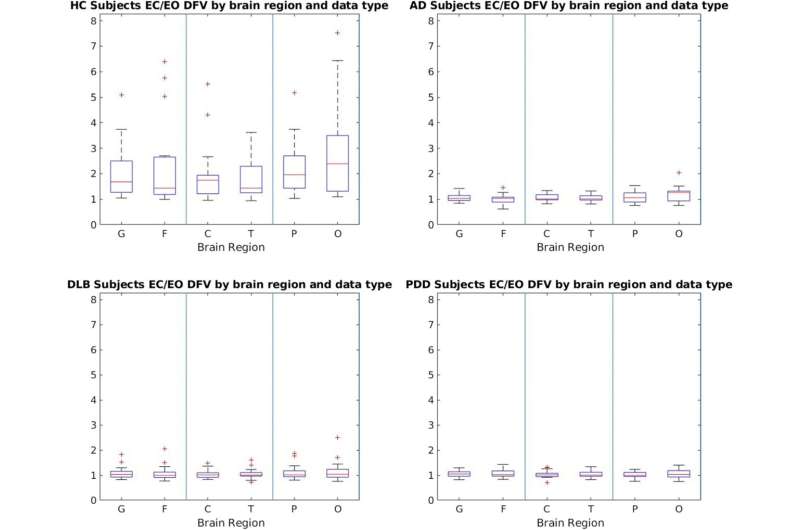Box plots for the dominant frequency variance (DFV) ratio in the eyes closed (EC) and eyes open (EO) resting state for HC, AD, DLB and PDD participants across all cortical regions. These boxplots display a possible difference between healthy and dementia participants when comparing eyes closed and open states that has yet been uncommented upon in literature for inter-group differentiation and may be representative on an underlying biomarker. The HC group showed a significant difference (p < 0.05) in comparison to all dementia groups for the ratio of EC and EO DFV. In addition, no dementia group was found to have a significant difference with any group other than HC, as shown in supplementary Table 6. “–” is the median DFV value of the group, with “+” representing outliers. Credit: Alzheimer's Research & Therapy (2022). DOI: 10.1186/s13195-022-01046-z
Forms of dementia could be spotted sooner and more easily by analyzing recordings of patients' electrical brain activity using artificial intelligence (AI), according to new research.
Scientists from the University of Surrey and the University of Newcastle have shown that it is possible to use electroencephalography (EEG) as a low-cost diagnostic tool to help clinicians identify different forms of dementia, including Lewy body, Alzheimer's and Parkinson's dementia.
Dr. Roman Bauer, senior author of the study from the University of Surrey, said, "Our study shows that using artificial intelligence analysis of EEG data as a diagnostic tool to identify dementia could be life-changing for many people.
"We have shown that by combining brain activity captured from patients with their eyes open and with their eyes closed, our machine learning algorithms can accurately detect different forms of dementia, including Lewy body dementia, which is often only found post-mortem. As a result, we believe that our method could allow people to be diagnosed and treated sooner.
"The clear next step for our project is to gather support for a clinical trial for this incredibly promising technology."
In the study, the researchers used EEG data (with eyes open and with eyes closed) from 40 people living with dementia in their 70s. In addition, the study used 15 health control subjects.
According to the World Health Organization, 55 million people live with dementia worldwide. However, studies have shown that Lewy body dementia can be found in more than 25% of dementia cases post-mortem, suggesting that there is an under-representation of that specific type in current data.
The study has been published in Alzheimer's Research & Therapy.
More information: Jack L. Jennings et al, Investigating the power of eyes open resting state EEG for assisting in dementia diagnosis, Alzheimer's Research & Therapy (2022). DOI: 10.1186/s13195-022-01046-z
Journal information: Alzheimer\'s Research & Therapy
Provided by University of Surrey
























